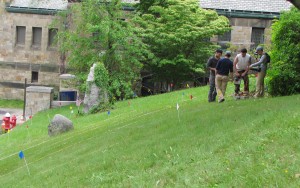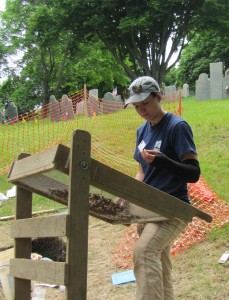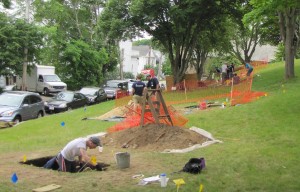Welcome to the University of Massachusetts Boston’s Archaeological Field School in Plymouth! We are carefully digging along the perimeter of historic Burial Hill Cemetery this month to look for remnants of the earlier buildings that stood here, including Plymouth Colony’s first fort from 1621. We started work in late May, and the work has been exciting.
In partnership with Plimoth Plantation, we have a team of graduate and undergraduate students working alongside professors from UMass Boston’s Andrew Fiske Memorial Center for Archaeological Research and the University’s Anthropology Department. We are hoping to discover part of the 17th-century palisade wall that encircled the fort and ran about a half-mile around the original settlement in Plymouth. The fort, atop Burial Hill, was used for the town’s defense through the time of the King Phillip’s War in the 1670s. Afterward, the hill became a burial ground with gravestones dating back to the 1680s.
Our team will not be digging or disturbing historic graves and monuments along Burial Hill, which was listed on the National Register of Historic Places in 2013.
The excavation site is located along School Street beside the First Parish of Plymouth of 1620. A reconstruction of the fort and the palisade wall stands in nearby Plimouth Plantation. Our team is working out of Plimoth Plantation’s facilities and collaborating about site interpretation with the museum staff. In May, we used ground-penetrating radar – or geophysical survey devices – on Burial Hill to try to detect parts of the earlier buildings and original palisade structure. Through June 27, we will be excavating along School Street.
This summer’s work is part of “Project 400: The Plymouth Colony Archaeological Survey,” a site survey and excavation leading up to the 400th anniversary of New England’s first permanent English settlement in 1620, the founding of Plymouth Colony. It is our objective to add a scholarly perspective to the discussion around this significant milestone. We have extensive experience doing archaeological digs in urban settings including Faneuil Hall in Boston and Newport, RI.
We have permits from the Massachusetts Historical Commission and the Town of Plymouth to conduct the surveys and funding from state and national organizations. For more information about the Fiske Center, please visit http://www.fiskecenter.umb.edu. For information about Plimoth Plantation, visit www.plimoth.org.
We will be working Monday-Friday, 9 a.m. to 3 p.m., through June 27, and we welcome visitors.



